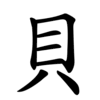貝
| ||||||||
Translingual
| Stroke order | |||
|---|---|---|---|
| Stroke order | |||
|---|---|---|---|
 | |||
Han character
貝 (radical 154, 貝+0, 7 strokes, cangjie input 月山金 (BUC), four-corner 60800, composition ⿱目八)
- Kangxi radical #154, ⾙.
Derived characters
- Index:Chinese radical/貝
References
- KangXi: page 1204, character 1
- Dai Kanwa Jiten: character 36656
- Dae Jaweon: page 1665, character 2
- Hanyu Da Zidian: volume 6, page 3622, character 1
- Unihan data for U+8C9D
Chinese
| trad. | 貝 | |
|---|---|---|
| simp. | 贝 | |
Glyph origin
| Historical forms of the character 貝 | ||||
|---|---|---|---|---|
| Shang | Western Zhou | Warring States | Shuowen Jiezi (compiled in Han) | Liushutong (compiled in Ming) |
| Oracle bone script | Bronze inscriptions | Chu Slip and silk script | Small seal script | Transcribed ancient scripts |
 |
 |
 |
 |
 |
| Characters in the same phonetic series (貝) (Zhengzhang, 2003) | |
|---|---|
| Old Chinese | |
| 貝 | *paːds |
| 狽 | *paːds |
| 鋇 | *paːds |
| 浿 | *pʰaːds, *pʰreːds |
| 垻 | *praːs |
| 敗 | *praːds, *braːds |
| 唄 | *braːds |
Etymology
Cowries were used as money in ancient China (Shell money). Guo (1945) proposes that cowries used by the ancient Chinese dynasties in Central China must have come from the southeastern shores of China and areas further south, as the species of sea snail used as decoration and currency—Monetaria moneta (money cowry)—is not native to the eastern seashores of China. He further proposes that in addition to the cowry itself, the word for cowry, 貝, is also an ancient loanword from languages of the south (which call it “bia”).
Compare Malay bia (“cowry”), Thai เบี้ย (bîia, “cowry shell; money”), Proto-Mon-Khmer *ɓa(a)j (“bean, small weight or coin”) > Khasi sbâi, 'bâi (“money, cowry, shell”), Khmer ពៃ (pɨy, “obsolete small coin”).
Alternatively, Starostin, Matisoff (2003) and Schuessler (2007) relate 貝 to Proto-Sino-Tibetan *bwap (“snail”), via 貝 (OC *paːds) < *pāps. If so it would be cognate with Jingpho pawp, lapawp (“snail”).
Pronunciation
Compounds
|
|
|
Japanese
Readings
Etymology
| Kanji in this term |
|---|
| 貝 |
| かい Grade: 1 |
| kun’yomi |
/*kapi1/ → /kaɸi/ → /kawi/ → /kai/
From Old Japanese.[1] Found in the Man'yōshū, completed some time after 759 CE.[2]
Derived terms
References
- 1988, 国語大辞典(新装版) (Kokugo Dai Jiten, Revised Edition) (in Japanese), Tōkyō: Shogakukan
- c. 759, Man'yōshū (book 15, poem 3709), text here
- 2006, 大辞林 (Daijirin), Third Edition (in Japanese), Tōkyō: Sanseidō, ISBN 4-385-13905-9
- 1998, NHK日本語発音アクセント辞典 (NHK Japanese Pronunciation Accent Dictionary) (in Japanese), Tōkyō: NHK, ISBN 978-4-14-011112-3
- 1974, 新明解国語辞典 (Shin Meikai Kokugo Jiten), Second Edition (in Japanese), Tōkyō: Sanseidō